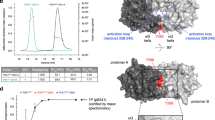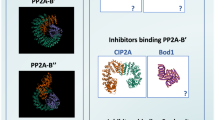Abstract
The haematopoietic protein tyrosine phosphatase (HePTP) is a negative regulator of the MAP kinases Erk1, Erk2 and p38. HePTP binds to these kinases through a kinase-interaction motif (KIM) in its non-catalytic amino terminus and inactivates them by dephosphorylating the critical phosphorylated tyrosine residue in their activation loop. Here we show that cyclic-AMP-dependent protein kinase (PKA) phosphorylates serine residue 23 in the KIM of HePTP in vitro and in intact cells. This modification reduces binding of MAP kinases to the KIM, an effect that is prevented by mutation of serine 23 to alanine. The PKA-mediated release of MAP kinase from HePTP is sufficient to activate the kinase and to induce transcription from the c-fos promoter. Expression of a HePTP serine-23-to-alanine mutant inhibits MAP-kinase dissociation and activation and induction of transcription from the c-fos promoter. We conclude that HePTP not only controls the activity of MAP kinases, but also mediates crosstalk between the cAMP system and the MAP-kinase cascade.
This is a preview of subscription content, access via your institution
Access options
Subscribe to this journal
Receive 12 print issues and online access
$209.00 per year
only $17.42 per issue
Buy this article
- Purchase on Springer Link
- Instant access to full article PDF
Prices may be subject to local taxes which are calculated during checkout






Similar content being viewed by others
References
Scott, J. D. Cyclic nucleotide-dependent protein kinases. Pharmacol. Ther. 50, 123–145 (1991).
Skålhegg, B. S. & Taskén, K. Specificity in the cAMP/PKA signaling pathway. Differential expression, regulation, and subcellular localization of subunits of PKA. Front. Biosci. [online] 2, d331–342 <http://www.bioscience.org/>(1997).
Kammer, G. M. The adenylate cyclase-cAMP-protein kinase A pathway and regulation of the immune response. Immunol. Today 9, 222–229 (1988).
Ledbetter, J. A. et al. Antibody binding to CD5 (Tp67) and Tp44 T cell surface molecules: effects on cyclic nucleotides, cytoplasmic free calcium, and cAMP-mediated suppression. J. Immunol. 137, 3299–3305 (1986).
Kammer, G. M., Boehm, C. A., Rudolph, S. A. & Schultz, L. A. Mobility of the human T lymphocyte surface molecules CD3, CD4, and CD8: regulation by a cAMP-dependent pathway. Proc. Natl Acad. Sci. USA 85, 792–796 (1988).
Skålhegg, B. S. et al. Cyclic AMP-dependent protein kinase type I mediates the inhibitory effects of 3",5"-cyclic adenosine monophosphate on cell replication in human T lymphocytes. J. Biol. Chem. 267, 15707–15714 (1992).
Choudhry, M. A., Uddin, S. & Sayeed, M. M. Prostaglandin E2 modulation of p59fyn tyrosine kinase in T lymphocytes during sepsis. J. Immunol. 160, 929–935 (1998).
Skålhegg, B. S. et al. Location of cAMP-dependent protein kinase type I with the TCR/CD3 complex. Science 263, 84–87 (1994).
Levy, F. O. et al. Cyclic AMP-dependent protein kinase (cAK) in human B cells: co-localization of type I cAK (RIα2C2) with the antigen receptor during anti-immunoglobulin-induced B cell activation. Eur. J. Immunol. 26, 1290–1296 (1996).
Torgersen, K. M. et al. Selective activation of cAMP-dependent protein kinase type I inhibits rat natural killer cell cytotoxicity. J. Biol. Chem. 272, 5495–5500 (1997).
Whisler, R. L., Beiqing, L., Grants, I. S. & Newhouse, Y. G. Cyclic AMP modulation of human B cell proliferative responses: role of cAMP-dependent protein kinases in enhancing B cell responses to phorbol diesters and ionomycin. Cell. Immunol. 142, 398–415 (1992).
Kammer, G. M., Khan, I. U. & Malemud, C. J. Deficient type I protein kinase A isozyme activity in systemic lupus erythematosus T lymphocytes. J. Clin. Invest. 94, 422–430 (1994).
Aandahl, E. M. et al. Protein kinase A type I antagonist restores immune responses of T cells from HIV-infected patients. FASEB J. 12, 855–862 (1998).
Mustelin, T. et al. Lymphocyte activation: the coming of the phosphatases. Front. Biosci. [online] 3, d1060–1096 < http://www.bioscience.org/> (1998).
Mustelin, T. et al. The next wave: protein tyrosine phosphatases enter T cell antigen receptor signaling. Cell. Signal. (in the press).
Zanke, B. et al. Cloning and expression of an inducible lymphoid-specific protein tyrosine phosphatase (HePTPase). Eur. J. Immunol. 22 235–239 (1992).
Saxena, M., Williams, S., Gilman, J. & Mustelin, T. Negative regulation of T cell antigen receptor signaling by hematopoietic tyrosine phosphatase (HePTP). J. Biol. Chem. 273, 15340–15344 (1998).
Saxena, M., Williams, S., Brockdorff, J., Gilman, J. & Mustelin, T. Inhibition of T cell signaling by MAP kinase-targeted hematopoietic tyrosine phosphatase (HePTP). J. Biol. Chem. 274, 11693–11700 (1999).
Lombroso, P. J., Murdoch, G. & Lerner, M. Molecular characterization of a protein-tyrosine-phosphatase enriched in striatum. Proc. Natl Acad. Sci. USA 88, 7242–7246 (1991).
Sharma, E. & Lombroso, P. J. A neuronal protein tyrosine phosphatase induced by nerve growth factor. J. Biol. Chem. 270, 49–53 (1995).
Shiozuka, K. Y., Watanabe, T., Ikeda, S., Hashimoto, S. & Kawashima, H. Cloning and expression of PCPTP1 encoding protein tyrosine phosphatase. Gene 162, 279–284 (1995).
Ogata, M., Sawada, M., Fujino, Y. & Hamaoka, T. cDNA cloning and characterization of a novel receptor-type protein tyrosine phosphatase expressed predominantly in the brain. J. Biol. Chem. 270, 2337–2343 (1995).
Pulido, R., Zuñiga, A. & Ullrich, A. PTP-SL and STEP protein tyrosine phosphatases regulate the activation of the extracellular signal-regulated kinases ERK1 and ERK2 by association through a kinase interaction motif. EMBO J. 17, 7337–7350 (1998).
Sweiter, M., Berenstein, E. H., Swaim, W. D. & Siraganian, R. P. Aggregation of IgE receptors in rat basophilic leukemia 2H3 cells induce tyrosine phosphorylation of the cytosolic protein-tyrosine phosphatase HePTP. J. Biol. Chem. 270, 21902–21906 (1995).
Cobb, M. H. et al. Regulation of the MAP kinase cascade. Cell. Mol. Biol. Res. 40, 253–256 (1994).
Flint, A. J., Tiganis, T., Barford, D. & Tonks, N. K. Development of “substrate-trapping” mutants to identify physiological substrates of protein tyrosine phosphatases. Proc. Natl Acad. Sci. USA 94, 1680–1685 (1997).
Chen, T., Cho, R. W., Stork, P. J. S. & Weber, M. J. Elevation of cyclic adenosine 3",5"-monophosphate potentiates activation of mitogen-activated protein kinase by growth factors in LNCaP prostate cancer cells. Cancer Res. 59, 213–218 (1999).
Straus, D. B. & Weiss, A. Genetic evidence for the involvement of the lck tyrosine kinase in signal transduction through the T cell antigen receptor. Cell 70, 585–593 (1992).
Whitmarsh, A. J., Shore, P., Sharrocks, A. D. & Davis, R. J. Integration of MAP kinase signal transduction pathways at the serum response element. Science 269, 403–407 (1995).
Keyse, S. M. & Emslie, E. A. Oxidative stress and heat shock induce a human gene encoding a protein tyrosine phosphatase. Nature 359, 644–647 (1992).
Rohan, P. J. et al. PAC-1: a mitogen-induced nuclear protein tyrosine phosphatase. Science 259, 1763–1766 (1993).
Noguchi, T. et al. Structure, mapping, and expression of erp, a growth factor-inducible gene encoding a nontransmembrane protein tyrosine phosphatase, and effect of ERP on cell growth. Mol. Cell. Biol. 13, 5195–5205 (1993).
Sun, H., Charles, C. H., Lau, L. F. & Tonks, N. K. MKP-1 (3CH134), an immediate early gene product, is a dual specificity phosphatase that dephosphorylates MAP kinase in vivo. Cell 75, 487–493 (1994).
Muda, M. et al. MKP-3, a novel cytosolic protein-tyrosine phosphatase that exemplifies a new class of mitogen-activated protein kinase phosphatase. J. Biol. Chem. 271, 4319–4326 (1996).
Camps, M. et al. Catalytic activation of the phosphatase MKP-3 by Erk2 mitogen-activated protein kinase. Science 280, 1262–1265 (1998).
Kemp, B. E. & Pearson, R. B. Protein kinase recognition sequence motifs. Trends Biochem. Sci. 15, 342–346 (1990).
Garton, A. & Tonks, N. K. PTP-PEST: a protein tyrosine phosphatase regulated by serine phosphorylation. EMBO J. 13, 3763–3771 (1994).
Zhang, S.-H., Kobayashi, R., Graves, P. R., Piwnica-Worms, H. & Tonks, N. K. Serine phosphorylation-dependent association of the Band 4.1-related protein tyrosine phosphatase PTPH1 with 14-3-3β protein. J. Biol. Chem. 272, 27281–27287 (1997).
Montminy, M. R. & Bilezikjian, L. M. Binding of a nuclear protein to the cyclic-AMP response element of the somatostatin gene. Nature 328, 175–178 (1987).
Graves, L. M. et al. Protein kinase A antagonizes platelet-derived growth factor-induced signaling by mitogen-activated protein kinase in human arterial smooth muscle cells. Proc. Natl Acad. Sci. USA 90, 10300–10304 (1993).
Cook, S. J. & McCormick, F. Inhibition by cAMP of Ras-dependent activation of Raf. Science 262, 1069–1072 (1993).
von Willebrand, M. et al. Inhibition of phosphatidylinositol 3-kinase blocks TCR/CD3-induced activation of the mitogen-activated kinase Erk2. Eur. J. Biochem. 235, 828–835 (1996).
Hata, D. et al. Bruton’s tyrosine kinase-mediated interleukin-2 gene activation in mast cells. J. Biol. Chem. 273, 10979–10987 (1998).
Williams, S. et al. Reconstitution of TCR-induced Erk2 kinase activation in Lck-negative JCaM1 cells by Syk, but not Zap. Eur. J. Biochem. 245, 84–90 (1997).
Jascur, T., Gilman, J. & Mustelin, T. Involvement of phosphatidylinositol 3-kinase in NFAT activation in T cells. J. Biol. Chem. 272, 14483–14488 (1997).
Luo, K., Hurley, T. R. & Sefton, B. M. Transfer of proteins to membranes facilitates both cyanogen bromide cleavage and two-dimensional proteolytic mapping. Oncogene 5, 921–923 (1990).
Couture, C. et al. Regulation of the Lck SH2 domain by tyrosine phosphorylation. J. Biol. Chem. 271, 24880–24884 (1996).
Bergman, M. et al. The human p50csk tyrosine kinase phosphorylates p56lck at Tyr-505 and down regulates its catalytic activity. EMBO J. 11, 2919–2924 (1992).
Acknowledgements
We thank B. Zanke for HePTP cDNA and for discussions; J. Schnitzer for comments on the manuscript; and M. Pelimiano and D. Hammi for technical assistance. This work was supported by NIH grants AI35603, AI41481 and AI40552.
Correspondence and requests for materials should be addressed to T.M.
Author information
Authors and Affiliations
Corresponding author
Rights and permissions
About this article
Cite this article
Saxena, M., Williams, S., Taskén, K. et al. Crosstalk between cAMP-dependent kinase and MAP kinase through a protein tyrosine phosphatase. Nat Cell Biol 1, 305–310 (1999). https://doi.org/10.1038/13024
Received:
Revised:
Accepted:
Published:
Issue Date:
DOI: https://doi.org/10.1038/13024
This article is cited by
-
Psychoneuroimmunology Meets Neuropsychopharmacology: Translational Implications of the Impact of Inflammation on Behavior
Neuropsychopharmacology (2012)
-
Structural basis of p38α regulation by hematopoietic tyrosine phosphatase
Nature Chemical Biology (2011)
-
PTPRR Protein Tyrosine Phosphatase Isoforms and Locomotion of Vesicles and Mice
The Cerebellum (2009)
-
Loss of the VHR dual-specific phosphatase causescell-cycle arrest and senescence
Nature Cell Biology (2006)
-
Promiscuous drugs compared to selective drugs (promiscuity can be a virtue)
BMC Clinical Pharmacology (2005)



